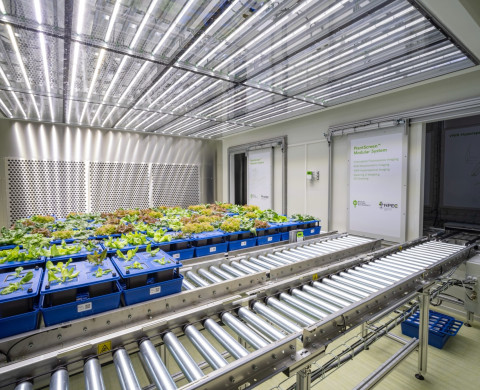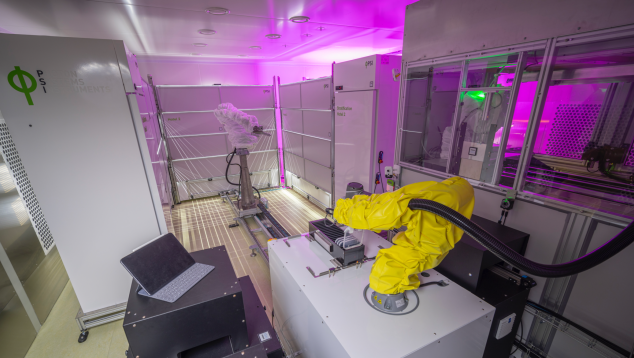NPEC – Plant-Microbe Interaction Phenotyping

Details
- Infrastructure type
- Ecotron indoor
- Institute
The Plant-Microbe-Interaction Phenotyping Module consists of two independent phenotyping installations designed for high-throughput phenotyping of the plant shoot (Helios) and in-vitro root system (Hades).
The facility
The Plant-Microbe Interaction Phenotyping Module comprises two advanced, independent phenotyping systems that enable high-throughput phenotyping of both the plant shoot (Helios) and the in-vitro root system (Hades).
Helios facilitates the automatic characterization of above-ground plant properties for various plant species and research purposes. It can accommodate between 63 and 1,260 plants in soil pots ranging from 250 mL to 5 L, with a maximum plant height of 100 cm, all under controlled environmental conditions. The system automates plant handling and irrigation while utilizing state-of-the-art imaging sensors for phenotyping, including 3D laser scanning triangulation, RGB morphometric imaging, Chlorophyll and multi-color fluorescence, and VNIR hyperspectral imaging. Dedicated image analysis pipelines extract phenotypic traits related to plant growth, morphology, photosynthetic performance, and reflectance properties in the visible and near-infrared spectrum. Additionally, HELIOS operates under PCM III conditions, making it suitable for working with genetically modified organisms (GMOs) and quarantine microorganisms.
Hades allows the characterization of in-vitro root systems. It can automatically process up to 10,000 seedlings on more than 2,000 Petri dishes, automating processes like filling Petri dishes, seed sowing, vernalization, and plant growth under controlled environmental conditions. Moreover, Hades enables automated treatment of roots with beneficial microbes or synthetic communities. The system performs non-destructive, automated assessments of plant dynamics by providing quantitative descriptions of root system architecture and the localization and quantification of fluorescent proteins expressed by plant roots or root-associated microorganisms. It utilizes advanced fluorescence and VNIR hyperspectral imaging techniques.
Research topics
Plants, roots, microbes, plant-microbe interaction, phenotyping
Running period
2023-undetermined
Equipment
Helios – Plant Shoot Architecture
- 3D laser scanning triangulation
- RGB Morphometric Imaging
- High-Sensitivity Kinetic Chlorophyll Fluorescence Imaging
- Multi-Excitation Fluorescence Imaging
- VNIR hyperspectral imaging
Hades – Plant Root Architecture
- B&W Morphometric Imaging
- High-Sensitivity Kinetic Chlorophyll Fluorescence Imaging
- Multi-Excitation Fluorescence Imaging
- VNIR Hyperspectral Imaging
Data management
Within NPEC, each module is outfitted with advanced imaging and sensor systems, initially storing acquired data on the local hard drives of individual PCs. NPEC has implemented a data framework to ensure automatic synchronization of this data from local PCs to either Microsoft Azure or high-end local network storage solutions. This synchronized data, referred to as 'hot', remains available on these systems for several months after the experiments have been ended.
Users can securely access this data through MS Azure, even daily during their ongoing experiment, allowing researchers to monitor the progress of the experiments from commencement to conclusion. The NPEC data module has been developed to refine raw sensor data into coherent and usable information for every imaging system and sensor in each module. NPEC is storing data according to the FAIR principles, and to enable re-usability extensive metadata information is stored with the phenotypic data, where the guidelines of MIAPPE are followed. Utilizing Artificial Intelligence (AI) and other sophisticated data processing tools, using automated Python scripts and VM technologies, the module handles complex tasks such as the bulk processing of UAV/ drone images, sensor fusion of multiple imaging systems and extraction of phenotypic traits from 3D point clouds with precision and reliability. For long-term preservation, the data is subsequently transferred to iRODS and is archived on tape. Medio 2023, NPEC already collected and archived 1.000’s of terabytes.
Conditions for access
Research questions or experiments with the Plant-Microbe Interaction Phenotyping Module can be requested via a form on the NPEC website: www.npec.nl.
Details
- Infrastructure type
- Ecotron indoor
- Institute


